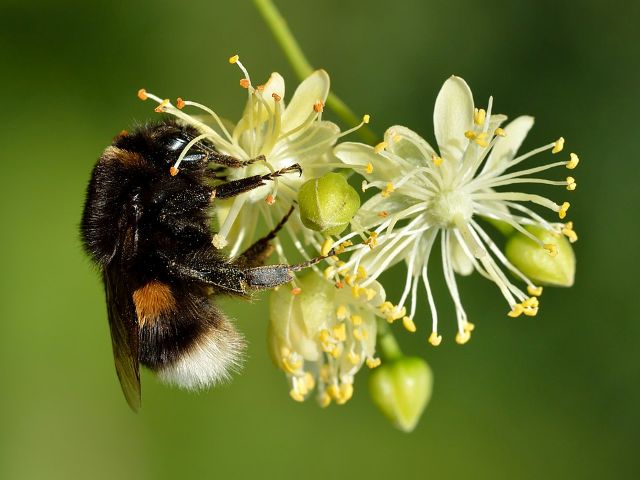Bumblebee queens force plants to accelerate blooming
Early spring is a crucial time for bumblebee queens. Their larvae need pollen while flowering plants are scarce. But bumblebees can accelerate pollen production, Priska Flury and colleagues report.
In mid-March, bumblebee queens wake up from their hibernation. They had mated in fall and stored sperm cells and then spent the winter alone in rest. Now it is time to start a colony. Each bumblebee queen looks for a place, makes a nest, lays eggs in it and feeds the larvae, which grow on a diet of pollen. They pupate and five weeks after the queen started the nest, the first workers emerge and help her. Until then, it is toiling.
And it is precisely during this busy period that only few plants are flowering and pollen for the larvae is difficult to find. That is unfortunate. But bumblebee queens have a special trick. They accelerate the flowering of plants so that pollen becomes available sooner, Priska Flury and colleagues show. They manipulate plants.
Crescents
A bumblebee queen does so by cutting holes in leaves of non-flowering plants, using her tongue and jaws. These holes have a characteristic crescent shape. What exactly happens in the plant is not clear, but the effect is: the plant flowers a few weeks earlier.
The researchers, who work in Switzerland, first investigated in the lab the clipping behaviour of commercially bred queens of buff-tailed bumblebees (Bombus terrestris) on non-flowering specimens of black mustard and tomato. When queens had little pollen in stock, they would make holes. When there was enough pollen, they would not.
They then captured queens of other bumblebee species in the field and tested in the lab whether they also clipped holes when they were deprived of pollen. Of the forty-one bumblebee species living in Switzerland, they tested seventeen, and the queens of twelve species appeared to make holes, including red-tailed bumblebee (Bombus lapidarius), white-tailed bumblebee (B. lucorum), and early bumblebee (B. pratorum). The other species did not cut holes in the lab, but that does not rule out that they do so in the field.
Plants in which queens had cut holes flowered a few weeks earlier than plants that had not been cut. As a control, the researchers themselves made holes in some plants, but that had almost no effect.
Critical period
So, bumblebee queens ‘order’ pollen when they need it. Previous research had shown that workers of a number of bumblebee species make holes in leaves when there is a high demand for pollen to advance flowering. They do so to survive periods with few flowers when bumblebee colonies are growing rapidly. At the end of April, it is over, because from that time on there is always enough pollen to be found.
That bumblebee queens cut holes is probably more important than the cutting behaviour of workers because early spring, whith no workers around, is a critical period. It depends on this period whether a young colony will survive and grow into a large and successful colony.
Workers and queens have special ‘baskets’ (scopae) on their hind legs to store and transport pollen. They need pollen not only for the larvae, but it is also a source of protein for themselves; they get energy from nectar. When collecting pollen and nectar, they pollinate the flowers. Therefore, it will also be an advantage for plants if the flowering coincides with the time that bumblebees are foraging. The manipulation by bumblebees improves synchronization.
Willy van Strien
Photo: buff-tailed bumblebee queen on small-leaved linden. Ivar Leidus (Wikimedia Commons, Creative Commons CC BY-SA 4.0)
Sources:
Flury, P., S. Stade, C.M. De Moraes & M.C. Mescher, 2025. Leaf-damaging behavior by queens is widespread among bumblebee species. Communications Biology 8: 435. Doi: 10.1038/s42003-025-07670-3
Pashalidou, F.G., H. Lambert, T. Peybernes, M.C. Mescher & C.M. De Moraes, 2020. Bumble bees damage plant leaves and accelerate flower production when pollen is scarce. Science 368: 881-884. Doi: 10.1126/science.aay0496
